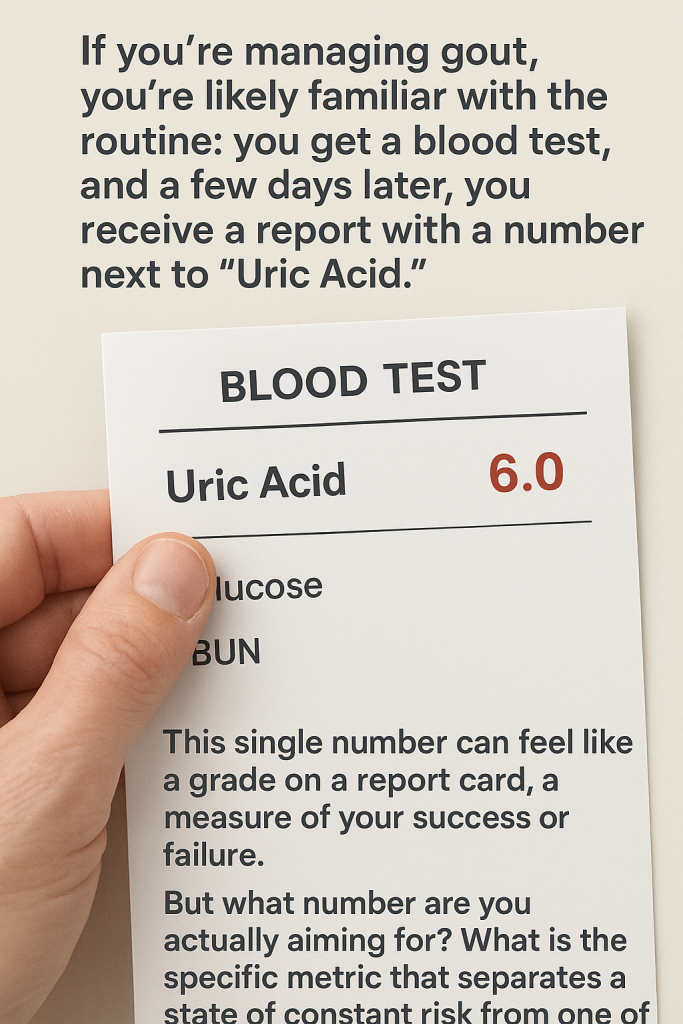
If you’re managing gout, you’re likely familiar with the routine: you get a blood test, and a few days later, you receive a report with a number next to “Uric Acid.” This single number can feel like a grade on a report card, a measure of your success or failure. But what number are you actually aiming for? What is the specific metric that separates a state of constant risk from one of true safety and control?
Many lab reports provide a “normal” reference range, but for a person with diagnosed gout, “normal” is not the same as “safe.” A level that might be harmless for the general population can still be high enough to cause excruciating flares and long-term joint damage in someone with gout.
The key to successful gout management lies in understanding and achieving a specific, science-backed therapeutic target. In this article, the experts at BISPIT will demystify this critical number. We will explain the internationally recognized target, the science behind it, and how a comprehensive strategy can help you get there and stay there.
Beyond “Normal”: Why Gout Requires a Therapeutic Target
First, it is essential to discard the idea of a generic “normal range.” A standard lab report might list a normal uric acid level for men as anything up to 7.0 mg/dL. However, for a person whose body has already proven it is sensitive to uric acid (by having a gout attack), this level is far too high.
This is because the science of gout is governed by a fundamental law of physics: the saturation point.
Your blood is a solution, and like any solution, it can only hold so much of a substance before it begins to solidify. For uric acid, that saturation point is approximately 6.8 mg/dL. Any level above this means your blood is “supersaturated,” creating the ideal conditions for sharp, painful monosodium urate crystals to form in your joints.
Therefore, the goal isn’t just to be within a “normal” range; it’s to be consistently and significantly below the point of saturation.
The “Magic Number”: The Internationally Recognized Target for Gout Control
Decades of research and clinical practice have led rheumatology experts around the world to a clear consensus. The primary goal of gout management, as established by leading authorities like the American College of Rheumatology (ACR), is to lower and maintain your serum uric acid level to:
Below 6.0 mg/dL (360 µmol/L)
This is the key metric. It is the number that represents safety and control.
Why is <6.0 mg/dL the target?
By keeping your uric acid level consistently below this threshold, you achieve two critical objectives:
- You Prevent New Crystal Formation: At a level below 6.0 mg/dL, your blood is no longer supersaturated. This makes it physically impossible for new urate crystals to form, effectively stopping the progression of the disease.
- You Allow Existing Crystals to Dissolve: This is the most powerful benefit. Maintaining a low uric acid level creates a “concentration gradient” that encourages the urate crystals already deposited in your joints and soft tissues (including tophi) to slowly dissolve back into the bloodstream, where they can be safely flushed out by the kidneys.
A More Aggressive Target: When to Aim Even Lower
For some individuals, an even lower target is recommended. The ACR guidelines suggest aiming for a target of below 5.0 mg/dL (300 µmol/L) for patients who have:
- Frequent gout flares.
- Visible tophi (gout stones).
- Evidence of joint damage on X-rays.
Why the lower target? A lower uric acid level creates a steeper concentration gradient, which can help dissolve large and stubborn tophi more quickly, leading to faster relief from chronic symptoms and halting joint destruction.
Achieving and Maintaining the Target: A Holistic BISPIT Strategy
Knowing your target is the first step. The next is building a sustainable strategy to reach it and, just as importantly, stay there. This requires a comprehensive approach.
1. Medical Foundation
For most people with established gout, especially those with tophi or frequent attacks, urate-lowering medication prescribed by a doctor is the most effective and essential tool for reaching the <6.0 mg/dL target.
2. Lifestyle and Diet
A gout-friendly diet and consistent hydration are crucial for supporting your medical treatment. By avoiding high-purine foods and drinking plenty of water, you reduce the overall metabolic load on your body, preventing the uric acid spikes that can undermine your progress.
3. The BISPIT Advantage: Your Partner in Stability
This is where targeted nutritional support becomes a game-changer. At BISPIT, our entire philosophy is built around providing natural, science-backed solutions to support your body’s own uric acid management systems. We see ourselves as your expert partner in achieving the stability that is so crucial for long-term success.
Our formulations, developed with high-purity natural extracts, are designed to work in synergy with your lifestyle and medical plan to:
- Support Healthy Uric Acid Excretion: BISPIT products contain ingredients that are chosen to help support the kidneys’ natural and efficient flushing of uric acid.
- Help Maintain Metabolic Balance: By providing your body with targeted phytonutrients, BISPIT helps create an internal environment that is less prone to the fluctuations that can challenge your management goals.
- Provide a Foundation for Consistency: Integrating BISPIT into your daily routine is a proactive step that helps you stay on track, providing a consistent layer of support that bridges the gaps in diet and lifestyle, helping you maintain that all-important <6.0 mg/dL target.
The True Meaning of “Safe”: Beyond a Number on a Page
Ultimately, the goal of reaching a “safe” uric acid level isn’t just about hitting a number. It’s about what that number represents for your quality of life. A consistently controlled uric acid level means:
- Freedom from the fear of the next flare.
- Halting the progression of joint damage.
- The dissolution of painful and deforming tophi.
- The ability to live an active, full life without limitations.
By understanding that the target is below 6.0 mg/dL, you are empowered with the knowledge to work effectively with your doctor and take control of your condition. With a comprehensive strategy that includes medical guidance, smart lifestyle choices, and the expert support of BISPIT, you can turn this critical metric into your new reality.
